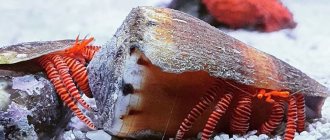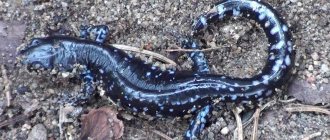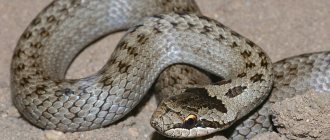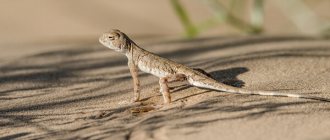- Wild animals
- >>
- Reptiles
The iguana is a fantastic looking creature. With a ridge along the back and tail, multiple skin textures and a scaly "beard". The animal looks like a small dragon. And although it is called the green iguana, it does not always have greenish skin tones. Coloration can range from blue-green, bright green, reddish, gray and yellow to pale pink and lavender. In some places, iguanas are even blue when young, but gradually change color as they age.
Description, structure, characteristics
The iguana is a fairly large lizard, its body length is on average 2 meters, with a weight of 5 to 9 kg. Although there are also smaller representatives, for example, the blue spiny iguana has a body length of only 30 cm.
Like other lizards, all iguanas have scaly skin. The scales themselves, depending on the type of iguana, can have different sizes and colors. Speaking of color, like their relatives chameleons, iguanas can change their color, although they do not do it as easily and naturally as chameleons. The iguana's coloring depends on the surrounding temperature; if it is colder, the iguana darkens. Conversely, as the temperature rises, the iguana becomes brighter.
Different types of iguanas have different colors, usually the coloring for them is created by nature in such a way as to blend in as much as possible with the surrounding landscape, so iguanas living in the jungle are usually green, with all possible shades of green.
How to distinguish an iguana from other lizards? After all, in its appearance it is similar to other representatives of this vast zoological family. A characteristic feature of the iguana is the presence of a spiny crest on its spine. This comb serves not only for beauty, but also to protect the animal.
The iguana has a thin spine and flexible body. The iguana's body is flattened on the sides, thanks to which it can easily crawl through even very narrow cracks.
The size of the iguana's tail is 2-3 times larger than the rest of the body of this lizard; the tail is equipped with developed muscles and also helps the iguana when moving. And just like other lizards, the iguana is capable of throwing off its tail in case of danger. The discarded tail grows back over time.
Interesting fact: the iguana's eyes can see even when closed. This is because her lower eyelid has a special depression that prevents the eye from closing completely. That is, the iguana simply physically cannot close its eyes completely. This unusual eye structure may also be a means of self-defense.
The structure of an iguana's teeth is similar to that of a human, and they also have the ability to regenerate; if, for one reason or another, a tooth falls out of this lizard, then after some time a new one will grow.
The iguana's tongue is endowed with an amazing ability - it can distinguish not only taste sensations, but also... smells, and is a full-fledged substitute for the iguana's nose, which is also in place and also distinguishes smells. As a result, all iguanas have an excellent sense of smell, because they have two organs to navigate the world of smells.
The iguana's paws have sharp claws that serve for self-defense; with their help, iguanas can move over various uneven surfaces and even climb a tree if necessary.
Save Status
Iguana species vary greatly not only in color, size and behavioral traits, but also in their conservation status in the wild. Some, such as the common iguana, are widespread in their natural and introduced habitats; other species, on the other hand, are vulnerable or endangered.
Threats to iguana populations include:
- habitat loss and destruction due to land clearing for housing, agriculture and livestock;
- the appearance of exotic animals preying on iguanas and their young;
- capture for sale as pets;
- poaching.
The Galapagos pink iguana, which has an estimated population of 192 individuals and a range of about 25 square kilometers, is critically endangered. Much of the population loss is due to rats and feral cats living on the island.
Photo: BBC Earth
The Exuma Island rock iguana, which exists in the popular tourist area of the Bahamas, is in danger of extinction due to the negative impacts of additional visitors to the island, as well as changes to the flora and fauna of its natural habitat. Plantations, homes and resorts have destroyed the plants that the iguanas fed on, and traffic has become one of the biggest threats to the free-roaming animals.
Iguanas also have many different natural predators:
- hawks;
- owls;
- snakes.
In addition, adult iguanas have been consumed by humans for thousands of years. In rural areas they are the main source of protein. Young iguanas are especially vulnerable to attack by wild cats, and no individual is safe from a pack of dogs. The only way iguanas defend themselves is to strike with their tail with sharp “spikes”.
Some species that were once abundant are now beginning to disappear. There are several measures that can help iguanas survive, such as managed care breeding, restrictions on hunting and trapping, and educational programs for people living in or near iguana habitats.
A technique called "headstarting" : iguana eggs are incubated indoors and the hatchlings are kept in large pens until they are large enough to protect themselves from predators, giving them a head start in the wild. Some individuals are relocated to smaller, uninhabited and protected islands or reefs where they can thrive.
Lifespan
How long do iguanas live? The lifespan of an iguana, depending on its species, ranges from 10 to 20 years. Moreover, iguanas often live longer at home than in the wild, where they are threatened by various predators. But the opposite situation also happens, when in captivity this reptile withers away faster.
To prolong the life of such an exotic pet, it is important to provide the iguana with proper maintenance and care, which we will discuss later in the article.
What does an iguana eat?
Photo: Iguana
Iguanas are primarily herbivores. Green leafy plants or ripe fruits are the preferred food. But sometimes they eat small amounts of meat or invertebrates. Iguanas use their tongues to manipulate food and bite small pieces to swallow without much chewing. The food is mixed with enzymes in the stomach and then passes into the small intestine, where pancreatic enzymes and bile mix with it. Most digestion occurs in the colon, where microflora breaks down cellulose. Microflora is necessary for the digestion of the hindguts of difficult-to-digest food of this species.
Fun fact: Iguana chicks tend to feed on adult feces, which may be an adaptation to acquire much-needed microflora. These microflora break down food and make it available for absorption.
In the first three years, iguanas require large amounts of dietary protein to grow quickly enough. During this period, young iguanas may consume insects and spiders. Older iguanas that have reached near maximum growth consume a low-phosphorus, high-calcium, leafy diet for their needs.
Iguanas are ectothermic animals. Their body temperature depends on the ambient temperature. Low temperatures suppress the iguana's appetite and reduce the activity of digestive enzymes. Active feeding usually occurs when the ambient temperature is 25-35 °C. Getting warm is an important aid to digestion. Iguanas may stop eating before or during their skin change. Females may refuse to eat during later stages of egg development. Individuals that are overly stressed or in new environments may also refuse to eat.
Now you know what to feed your iguana. Let's see how the green lizard lives.
Nutrition
What do iguanas eat? Iguanas are herbivores; their main food source is various plants, flowers, and sometimes even cacti. At home, the iguana can be fed with fruits and vegetables, herbs and mineral supplements; it is important to provide the pet with the amount of calcium and
phosphorus.
In addition to plant food, iguanas regularly need drinking water.
Lifestyle
Under natural conditions, iguanas are diurnal, like people, they sleep at night and are awake during the day. As habitats, they choose secluded places in thickets, on the banks of rivers and lakes. Tree iguanas, as their name suggests, live in trees. It is important that there are many edible plants nearby, proximity to water and a minimum of predators - these are ideal living conditions for an iguana.
Types, photos and names
Iguanas, like many other animals, have many different species; we will describe the most interesting of them.
Blue iguana
The blue iguana is the rarest and at the same time the most beautiful representative of the iguana family. It is one and a half meters long, weighs 15 kg and has a characteristic blue color. In natural conditions, it lives exclusively on the island of Grand Cayman in the Caribbean Sea. The blue iguana is critically endangered and listed in
Red Book.
Marine iguana
The Galapagos marine iguana, which lives on the Galapagos Islands, is notable for the fact that it is the only lizard in the world that can stay under water for a long time. In particular, only the marine iguana can hold its breath for an entire hour! However, from time to time, marine iguanas crawl onto land. Has a black color.
Green iguana
The common iguana is the most common species of iguana, living in many places in South and Central America, in particular the green iguana can be found in Brazil, Colombia, Venezuela, Costa Rica, Guatemala and other countries in this region. It has a characteristic green color, which helps the iguana living in the tropical jungle to remain as invisible as possible.
Collared iguana
The collared iguana is notable for the fact that it is the smallest among iguanas (but not among lizards), its length is only 35 cm. In addition, it has a rather funny appearance: a barrel-shaped body with a long tail and short legs. It lives in rocky and arid areas of Mexico.
Social structure
Photo: shikhei goh
Iguanas are solitary animals. During the rainy season, males become territorial , and form pairs exclusively for mating. The hatchlings may remain together in kin groups for a short period of time after leaving the nest.
Male iguanas show aggression towards other males in order to attract the attention of females and bask in the sun. Physical combat is rare and usually occurs between opponents of comparable size. During fights, significant damage can be caused to both parties.
Reproduction
Iguanas reach sexual maturity in the second or third year of life. During the mating season, which lasts, depending on the species, either in the fall or in January-February, males begin an active search for females for mating. They search for them mainly by smell. When several males lay claim to one female, fierce fights break out between them, during which the males enthusiastically beat each other with their long tails. During the mating season, the natural peacefulness of iguanas is replaced by a thirst to leave offspring. As a rule, the strongest male gets the female.
Once fertilized, after some time the female iguana lays eggs; usually there can be up to 6 eggs in one clutch. After three months, small iguanas hatch from them and are completely ready for adult and independent life.
Iguana eggs.
Interesting features
Iguanas have a third eye on the crown of their head, covered with a translucent film. Scientists still cannot determine its purpose and consider it a rudiment inherited from distant ancestors. But according to some studies, this organ responds to changing light conditions during the day.
Animals have very sharp teeth that can bite painfully. If a lizard loses a tooth, a new one quickly grows in place of the old one. A sharp crest, claws and a long tail serve as protection from enemies.
Iguanas have a very unique metabolism. Excess potassium salts are eliminated from the body not through the genitourinary system, but by sneezing. Many lizards have another unique property - the ability to catch odors with their tongues and see ultraviolet rays.
Keeping at home
Since iguanas are heat-loving lizards that cannot tolerate cold, it is very important to keep them in conditions that are as close to natural as possible. The temperature in the terrarium for iguanas should be 28-40 C. By lowering the temperature below 28 C, you risk “freezing” your heat-loving pets. To maintain the required temperature, it will be necessary to build a special heater under the terrarium.
It is necessary to place an ultraviolet lamp on top of the terrarium; thanks to its glow, domestic iguanas will receive the sufficient amount of light they need to maintain their body in normal condition.
Since iguanas love not only warm climates, but also humid ones, to maintain humidity in the terrarium there should be a small pool filled with clean drinking water. Among other things, iguanas love to soak in the water, and a small pool for this purpose will be just what they need + thanks to it they will be able to quench their thirst at any time.
A grass mat, or even just a regular mat, is perfect as a covering for a terrarium with an iguana. But sand, stones, and soil should not be poured there, as curious iguanas can taste the sand, which is not at all beneficial for their body.
Since many iguanas love to climb trees, you will also need to build various driftwood in the terrarium and place wooden sticks on which the iguanas will climb back and forth.
It is also important to ensure natural ventilation in the terrarium; without high-quality air circulation, the iguana will begin to develop various diseases, and ultimately this can lead to death. Simple holes in the top cover will not be enough; the best option would be a ventilation slot covered with a strong mesh.
And finally, it is worth noting that the terrarium itself should be located in a quiet place (ideally in a library or bedroom), out of the reach of dogs and cats, with whom iguanas are unlikely to make friends.
Natural enemies
The iguana has many enemies in its natural environment - birds of prey, some species of rodents, large snakes. Their prey in most cases is young, old or sick animals.
The adult individual, due to its coloring, often goes unnoticed in the dense green foliage of the tropical forest. It often flees from snakes or larger lizards. Only wounded animals show aggression. The rest prefer not to get into a fight.
Interesting Facts
Video
Author: Pavel Chaika, editor-in-chief of Poznavaika magazine
When writing the article, I tried to make it as interesting, useful and high-quality as possible. I would be grateful for any feedback and constructive criticism in the form of comments on the article. You can also write your wish/question/suggestion to my email [email protected] or Facebook, with respect, the author.
Author page
This article is available in English -
Iguana.











